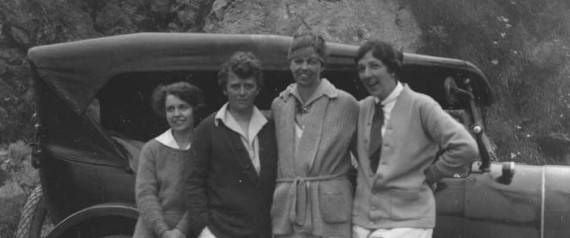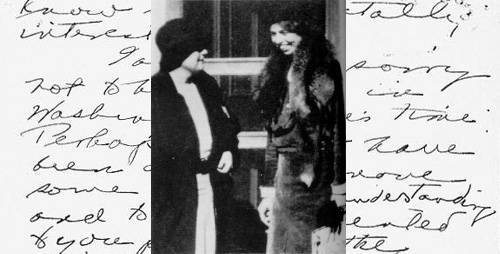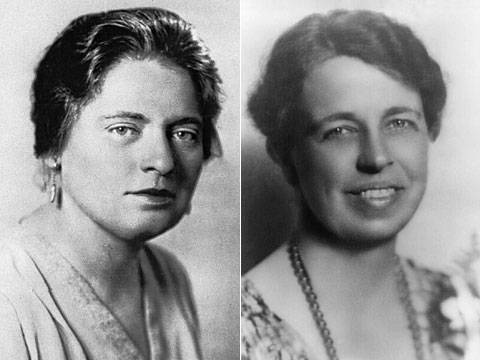- Joined
- Jan 25, 2014
- Messages
- 11,991
- Reaction score
- 1,411
- Points
- 159
Eleanor Roosevelt, The First Lady of Gay Rights
Huffington Post | By Marc Peyser | 06/20/2015 10:06 am EDT
[The story was co-written by Timothy Dwyer, co-author of Hissing Cousins: The Untold Story of Eleanor Roosevelt and Alice Longworth (Nan A. Talese/Doubleday)]
SOURCE
I was conflicted on whether to post this here in Gay News or in my thread Gay Icons. It's both a news story and a write up of a Gay Icon.
Huffington Post | By Marc Peyser | 06/20/2015 10:06 am EDT
[The story was co-written by Timothy Dwyer, co-author of Hissing Cousins: The Untold Story of Eleanor Roosevelt and Alice Longworth (Nan A. Talese/Doubleday)]

June marks the start of Gay Pride season, with parades from Boston and Los Angeles to Tel Aviv and Oslo. It's a good bet that somewhere over those rainbows, Eleanor Roosevelt's spirit will be marching, too. She's appeared off and on over the decades, whether loud and proud on posters reclaiming her as an uncelebrated lesbian or more demurely as a sort of mascot for branches of the Eleanor Roosevelt Democratic Club.
But this year, she deserves a special place of pride. June will also see the Supreme Court's thumbs-up or down ruling on gay marriage. Though Roosevelt was an extraordinary champion of African-American and women's rights, she also did more than almost anyone in the pre-Stonewall era to model acceptance of gay relationships -- and she did it in the White House.
Some would argue that was because the First Lady was a closeted lesbian. The most often-cited evidence is her intense friendship with an openly lesbian reporter named Lorena Hickok. Roosevelt and Hick worked together, vacationed together and wrote each other hundreds of letters, many of them as purple as a late-summer eggplant. "Gee! What wouldn't I give to talk to you & hear you now, oh, dear one," said one from Eleanor. "It is all the little things, tones in your voice, the feel of your hair, gestures, these are the things I think about & long for." The First Lady got Hick a job reporting from around the country on the progress of the New Deal. Back in Washington, she bunked in a guest room at 1600 Pennsylvania Avenue. And the rumors began. "And so you think they gossip about us?" Eleanor wrote to Lorena in November 1933. "I am always so much more optimistic than you are. I suppose because I care so little what 'they' say!"

Eleanor Roosevelt's Controversial Love Letters to Lorena Hickok
Over the years, the gossip has hardened into gospel. In 1998, Eleanor earned a spot alongside James Baldwin, Willa Cather and Cole Porter on a National Coming Out Day poster with the headline, "Unfortunately, history has set the record a little too straight." Five years ago, she shared top billing with Matthew Shepard, Cynthia Nixon and Maurice Sendak in the LGBT History Month celebration "31 Days, 31 Icons." She also merited a section in Neil Miller's 2005 book Out of the Past: Gay and Lesbian History from 1869 to the Present. Ask people today what they know about Eleanor Roosevelt and her sexuality invariably makes the short list.
Among folks who knew her, however, the consensus went the other way. Eleanor's children dismissed the idea that their mother was a lesbian; her son John believed that his mother did have an affair -- with her male body guard, a man named Earl Miller. (One of Miller's soon-to-be-ex-wives, citing allegedly steamy letters between him and Eleanor, threatened to name the former First Lady as a co-respondent in their divorce.) Alice Longworth, Eleanor's first cousin and a woman so free-spirited she claimed to have been named the first "honorary homosexual" by a Washington gay-rights organization, couldn't have been more insistent. "I don't care what they say," she said. "I simply cannot believe that Eleanor Roosevelt is a lesbian."

Lorena Hickok and Eleanor Roosevelt
Many of ER's letters to Hick express a passionate friendship. But people making the case for Eleanor's lesbianism tend to cherry-pick from her correspondence, overlooking passages where she acknowledges that Hick experienced "a feeling for me which for one reason or another I may not return in kind," and suggesting that, "you should have had a husband & children & it would have made you happy if you loved him & in any case it would have satisfied certain cravings."
Besides, Eleanor tended toward epistolary heavy-breathing in general, whether she was writing to her bodyguard or to her mother-in-law. "I do so want to kiss you," she wrote once to Franklin's mother, Sara Delano, "and in a little over a month I will be able to."
Eleanor Roosevelt isn't the only putatively straight historical figure to become a gay icon. Abraham Lincoln, Malcolm X, Katharine Hepburn and Anne Frank have all been posthumously embraced in some corners as unsung members of the larger gay family.
It's an understandable impulse. Minority communities crave role models, both as inspiration to their own and a retort to narrow-minded outsiders. American Jews have long outed the undetected sons and daughters of Abraham. Think there's a chance your favorite celebrity is Jewish? Check out heebz.com, which stockpiles the names of famous Jews "because," the site explains, "you gotta celebrate every success."
The irony is that Eleanor Roosevelt deserves to be a gay icon -- even if she was 100 percent straight. Homosexuality may have been stigmatized, even criminalized, during her lifetime, but that didn't stop her from befriending gay women regardless of what people thought of them or her. She lived for years with two out lesbians, Marion Dickerman and Nancy Cook, at her cottage in upstate New York, where the sheets and towels were monogrammed with the three women's initials: EMN. Later, in Greenwich Village, two of her closest friends were another lesbian couple, Esther Lape and Elizabeth Read. (Take the Oscar Wilde Gay History Tour of New York and see where they lived.) She invited these women to inaugurations, to meet the King and Queen of England -- anywhere she wanted the company of her closest friends.
We'll probably never know if Eleanor shared their sexual orientation or if she just admired independent women. Whatever the case, her refusal to let the morals of the day define her was a remarkable kind of heroism, almost like a one-woman gay-straight alliance. As the Supreme Court prepares to give its final word on the acceptability of gay marriages, they'd do well to
remember her historic example, regardless of whom she did, and didn't, sleep with.
SOURCE
I was conflicted on whether to post this here in Gay News or in my thread Gay Icons. It's both a news story and a write up of a Gay Icon.
